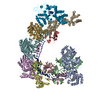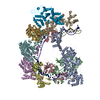+ Open data
Open data
- Basic information
Basic information
| Entry | Database: PDB / ID: 7u5d | |||||||||
|---|---|---|---|---|---|---|---|---|---|---|
| Title | I-F3b Cascade-TniQ full R-loop complex | |||||||||
 Components Components |
| |||||||||
 Keywords Keywords | DNA BINDING PROTEIN/DNA/RNA / CRISPR-Cas / Transposon / CAST / Cascade / I-F / I-F3 / DNA BINDING PROTEIN / DNA BINDING PROTEIN-DNA-RNA complex | |||||||||
| Function / homology | DNA / DNA (> 10) / DNA (> 100) / RNA / RNA (> 10) Function and homology information Function and homology information | |||||||||
| Biological species |  Aeromonas salmonicida (bacteria) Aeromonas salmonicida (bacteria) | |||||||||
| Method | ELECTRON MICROSCOPY / single particle reconstruction / cryo EM / Resolution: 3.52 Å | |||||||||
 Authors Authors | Park, J.U. / Mehrotra, E. / Kellogg, E.H. | |||||||||
| Funding support |  United States, 2items United States, 2items
| |||||||||
 Citation Citation |  Journal: Mol Cell / Year: 2023 Journal: Mol Cell / Year: 2023Title: Multiple adaptations underly co-option of a CRISPR surveillance complex for RNA-guided DNA transposition. Authors: Jung-Un Park / Michael T Petassi / Shan-Chi Hsieh / Eshan Mehrotra / Gabriel Schuler / Jagat Budhathoki / Vinh H Truong / Summer B Thyme / Ailong Ke / Elizabeth H Kellogg / Joseph E Peters /  Abstract: CRISPR-associated transposons (CASTs) are natural RNA-directed transposition systems. We demonstrate that transposon protein TniQ plays a central role in promoting R-loop formation by RNA-guided DNA- ...CRISPR-associated transposons (CASTs) are natural RNA-directed transposition systems. We demonstrate that transposon protein TniQ plays a central role in promoting R-loop formation by RNA-guided DNA-targeting modules. TniQ residues, proximal to CRISPR RNA (crRNA), are required for recognizing different crRNA categories, revealing an unappreciated role of TniQ to direct transposition into different classes of crRNA targets. To investigate adaptations allowing CAST elements to utilize attachment sites inaccessible to CRISPR-Cas surveillance complexes, we compared and contrasted PAM sequence requirements in both I-F3b CAST and I-F1 CRISPR-Cas systems. We identify specific amino acids that enable a wider range of PAM sequences to be accommodated in I-F3b CAST elements compared with I-F1 CRISPR-Cas, enabling CAST elements to access attachment sites as sequences drift and evade host surveillance. Together, this evidence points to the central role of TniQ in facilitating the acquisition of CRISPR effector complexes for RNA-guided DNA transposition. | |||||||||
| History |
|
- Structure visualization
Structure visualization
| Structure viewer | Molecule:  Molmil Molmil Jmol/JSmol Jmol/JSmol |
|---|
- Downloads & links
Downloads & links
- Download
Download
| PDBx/mmCIF format |  7u5d.cif.gz 7u5d.cif.gz | 683 KB | Display |  PDBx/mmCIF format PDBx/mmCIF format |
|---|---|---|---|---|
| PDB format |  pdb7u5d.ent.gz pdb7u5d.ent.gz | 536.6 KB | Display |  PDB format PDB format |
| PDBx/mmJSON format |  7u5d.json.gz 7u5d.json.gz | Tree view |  PDBx/mmJSON format PDBx/mmJSON format | |
| Others |  Other downloads Other downloads |
-Validation report
| Summary document |  7u5d_validation.pdf.gz 7u5d_validation.pdf.gz | 1.3 MB | Display |  wwPDB validaton report wwPDB validaton report |
|---|---|---|---|---|
| Full document |  7u5d_full_validation.pdf.gz 7u5d_full_validation.pdf.gz | 1.3 MB | Display | |
| Data in XML |  7u5d_validation.xml.gz 7u5d_validation.xml.gz | 111.2 KB | Display | |
| Data in CIF |  7u5d_validation.cif.gz 7u5d_validation.cif.gz | 175.4 KB | Display | |
| Arichive directory |  https://data.pdbj.org/pub/pdb/validation_reports/u5/7u5d https://data.pdbj.org/pub/pdb/validation_reports/u5/7u5d ftp://data.pdbj.org/pub/pdb/validation_reports/u5/7u5d ftp://data.pdbj.org/pub/pdb/validation_reports/u5/7u5d | HTTPS FTP |
-Related structure data
| Related structure data |  26348MC  7u5eC M: map data used to model this data C: citing same article ( |
|---|---|
| Similar structure data | Similarity search - Function & homology  F&H Search F&H Search |
- Links
Links
- Assembly
Assembly
| Deposited unit | 
|
|---|---|
| 1 |
|
- Components
Components
-RNA chain , 1 types, 1 molecules 1
| #1: RNA chain | Mass: 19399.604 Da / Num. of mol.: 1 Source method: isolated from a genetically manipulated source Source: (gene. exp.)  Aeromonas salmonicida (bacteria) / Production host: Aeromonas salmonicida (bacteria) / Production host:  |
|---|
-DNA chain , 2 types, 2 molecules 23
| #2: DNA chain | Mass: 35613.680 Da / Num. of mol.: 1 / Source method: obtained synthetically / Source: (synth.)  Aeromonas salmonicida (bacteria) Aeromonas salmonicida (bacteria) |
|---|---|
| #3: DNA chain | Mass: 35737.723 Da / Num. of mol.: 1 / Source method: obtained synthetically / Source: (synth.)  Aeromonas salmonicida (bacteria) Aeromonas salmonicida (bacteria) |
-Protein , 4 types, 10 molecules ABCDEFGHIJ
| #4: Protein | Mass: 78728.367 Da / Num. of mol.: 1 Source method: isolated from a genetically manipulated source Source: (gene. exp.)  Aeromonas salmonicida (bacteria) / Production host: Aeromonas salmonicida (bacteria) / Production host:  | ||||
|---|---|---|---|---|---|
| #5: Protein | Mass: 39105.172 Da / Num. of mol.: 6 Source method: isolated from a genetically manipulated source Source: (gene. exp.)  Aeromonas salmonicida (bacteria) / Production host: Aeromonas salmonicida (bacteria) / Production host:  #6: Protein | | Mass: 23640.832 Da / Num. of mol.: 1 Source method: isolated from a genetically manipulated source Source: (gene. exp.)  Aeromonas salmonicida (bacteria) / Production host: Aeromonas salmonicida (bacteria) / Production host:  #7: Protein | Mass: 46366.637 Da / Num. of mol.: 2 Source method: isolated from a genetically manipulated source Source: (gene. exp.)  Aeromonas salmonicida (bacteria) / Production host: Aeromonas salmonicida (bacteria) / Production host:  |
-Experimental details
-Experiment
| Experiment | Method: ELECTRON MICROSCOPY |
|---|---|
| EM experiment | Aggregation state: PARTICLE / 3D reconstruction method: single particle reconstruction |
- Sample preparation
Sample preparation
| Component | Name: I-F3b Cascade-TniQ Full R-loop complex / Type: COMPLEX / Entity ID: all / Source: RECOMBINANT | |||||||||||||||
|---|---|---|---|---|---|---|---|---|---|---|---|---|---|---|---|---|
| Molecular weight | Value: 0.45 MDa / Experimental value: NO | |||||||||||||||
| Source (natural) | Organism:  Aeromonas salmonicida (bacteria) Aeromonas salmonicida (bacteria) | |||||||||||||||
| Source (recombinant) | Organism:  | |||||||||||||||
| Buffer solution | pH: 7.5 | |||||||||||||||
| Buffer component |
| |||||||||||||||
| Specimen | Conc.: 0.9 mg/ml / Embedding applied: NO / Shadowing applied: NO / Staining applied: NO / Vitrification applied: YES | |||||||||||||||
| Specimen support | Grid material: COPPER / Grid type: Quantifoil R1.2/1.3 | |||||||||||||||
| Vitrification | Instrument: FEI VITROBOT MARK IV / Cryogen name: ETHANE / Humidity: 100 % / Chamber temperature: 277 K |
- Electron microscopy imaging
Electron microscopy imaging
| Experimental equipment |  Model: Titan Krios / Image courtesy: FEI Company |
|---|---|
| Microscopy | Model: FEI TITAN KRIOS |
| Electron gun | Electron source:  FIELD EMISSION GUN / Accelerating voltage: 300 kV / Illumination mode: FLOOD BEAM FIELD EMISSION GUN / Accelerating voltage: 300 kV / Illumination mode: FLOOD BEAM |
| Electron lens | Mode: BRIGHT FIELD / Nominal defocus max: 2500 nm / Nominal defocus min: 1000 nm |
| Image recording | Electron dose: 60 e/Å2 / Film or detector model: GATAN K3 BIOQUANTUM (6k x 4k) |
- Processing
Processing
| EM software |
| |||||||||||||||||||||||||||||||||
|---|---|---|---|---|---|---|---|---|---|---|---|---|---|---|---|---|---|---|---|---|---|---|---|---|---|---|---|---|---|---|---|---|---|---|
| CTF correction | Type: PHASE FLIPPING AND AMPLITUDE CORRECTION | |||||||||||||||||||||||||||||||||
| 3D reconstruction | Resolution: 3.52 Å / Resolution method: FSC 0.143 CUT-OFF / Num. of particles: 53353 / Symmetry type: POINT | |||||||||||||||||||||||||||||||||
| Atomic model building | Protocol: AB INITIO MODEL | |||||||||||||||||||||||||||||||||
| Atomic model building | PDB-ID: 6PIF Accession code: 6PIF / Source name: PDB / Type: experimental model |
 Movie
Movie Controller
Controller




 PDBj
PDBj
































































